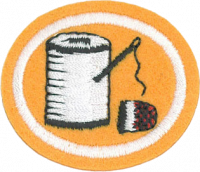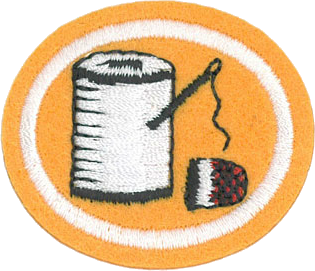Difference between revisions of "AY Honors/Basic Sewing/Answer Key/es"
From Pathfinder Wiki
< AY Honors | Basic SewingAY Honors/Basic Sewing/Answer Key/es
(Created page with "</noinclude>") |
(Updating to match new version of source page) |
||
| (5 intermediate revisions by 2 users not shown) | |||
| Line 1: | Line 1: | ||
| − | + | {{HonorSubpage}} | |
| − | + | <section begin="Body" /> | |
| − | {{ | ||
| − | |||
| − | |||
| − | |||
| − | |||
| − | |||
| − | |||
| − | |||
| − | }} | ||
| − | |||
| − | |||
| − | |||
| − | <section begin="Body" /> | ||
{{ansreq|page={{#titleparts:{{PAGENAME}}|2|1}}|num=1}} | {{ansreq|page={{#titleparts:{{PAGENAME}}|2|1}}|num=1}} | ||
<noinclude></noinclude> | <noinclude></noinclude> | ||
| − | <!-- 1. | + | <!-- 1. Describir el uso adecuado de los siguientes: --> |
<noinclude></noinclude> | <noinclude></noinclude> | ||
{{ansreq|page={{#titleparts:{{PAGENAME}}|2|1}}|num=1a}} | {{ansreq|page={{#titleparts:{{PAGENAME}}|2|1}}|num=1a}} | ||
| Line 48: | Line 35: | ||
{{ansreq|page={{#titleparts:{{PAGENAME}}|2|1}}|num=2}} | {{ansreq|page={{#titleparts:{{PAGENAME}}|2|1}}|num=2}} | ||
<noinclude></noinclude> | <noinclude></noinclude> | ||
| − | <!-- 2. | + | <!-- 2. Estar familiarizado con la máquina de coser en su casa o en la escuela. Identificar: --> |
<noinclude></noinclude> | <noinclude></noinclude> | ||
{{ansreq|page={{#titleparts:{{PAGENAME}}|2|1}}|num=2a}} | {{ansreq|page={{#titleparts:{{PAGENAME}}|2|1}}|num=2a}} | ||
| Line 98: | Line 85: | ||
{{ansreq|page={{#titleparts:{{PAGENAME}}|2|1}}|num=3}} | {{ansreq|page={{#titleparts:{{PAGENAME}}|2|1}}|num=3}} | ||
<noinclude></noinclude> | <noinclude></noinclude> | ||
| − | <!-- 3. | + | <!-- 3. Demostrar la manera correcta de colocar el hilo y hacer funcionar la máquina. --> |
| − | |||
{{clear}} | {{clear}} | ||
| Line 113: | Line 99: | ||
{{ansreq|page={{#titleparts:{{PAGENAME}}|2|1}}|num=4}} | {{ansreq|page={{#titleparts:{{PAGENAME}}|2|1}}|num=4}} | ||
<noinclude></noinclude> | <noinclude></noinclude> | ||
| − | <!-- 4. | + | <!-- 4. Poner un dobladillo en uno de los siguientes artículos mostrando puntos de sutura nítidos y emparejados. --> |
<noinclude></noinclude> | <noinclude></noinclude> | ||
| Line 147: | Line 133: | ||
{{ansreq|page={{#titleparts:{{PAGENAME}}|2|1}}|num=5}} | {{ansreq|page={{#titleparts:{{PAGENAME}}|2|1}}|num=5}} | ||
<noinclude></noinclude> | <noinclude></noinclude> | ||
| − | <!-- 5. | + | <!-- 5. Demostrar la habilidad para coser adecuadamente los botones y cierres. --> |
| − | |||
{{clear}} | {{clear}} | ||
| Line 158: | Line 143: | ||
{{ansreq|page={{#titleparts:{{PAGENAME}}|2|1}}|num=6}} | {{ansreq|page={{#titleparts:{{PAGENAME}}|2|1}}|num=6}} | ||
<noinclude></noinclude> | <noinclude></noinclude> | ||
| − | <!-- 6. | + | <!-- 6. Mencionar lo que entiende por orillo, sesgo y tejido atravesado. --> |
| − | |||
| − | |||
| − | |||
<noinclude></noinclude> | <noinclude></noinclude> | ||
| Line 167: | Line 149: | ||
{{ansreq|page={{#titleparts:{{PAGENAME}}|2|1}}|num=7}} | {{ansreq|page={{#titleparts:{{PAGENAME}}|2|1}}|num=7}} | ||
<noinclude></noinclude> | <noinclude></noinclude> | ||
| − | <!-- 7. | + | <!-- 7. Hacer una bolsa de lavandería para acampar o un artículo simple similar. --> |
| − | |||
| − | |||
{{clear}} | {{clear}} | ||
| Line 177: | Line 157: | ||
{{clear}} | {{clear}} | ||
| − | {{clear}} | + | {{clear}} |
{{clear}} | {{clear}} | ||
| Line 195: | Line 175: | ||
<noinclude></noinclude> | <noinclude></noinclude> | ||
==Referencias== | ==Referencias== | ||
| − | |||
<noinclude></noinclude> | <noinclude></noinclude> | ||
| − | + | ||
| + | [[Category:Adventist Youth Honors Answer Book/Do at home{{GetLangSuffix}}]] | ||
| + | {{CloseHonorPage}} | ||
Latest revision as of 15:33, 3 January 2023
Costura básica
Nivel de destreza
1
Año
1976
Version
15.11.2025
Autoridad de aprobación
Asociación General
1
Describir el uso adecuado de los siguientes:
1a
Dedal
1b
Cinta métrica
1c
Tijeras grandes y de podar
1d
Tijeras de picos (zigzag)
1e
Agujas de varios tamaños y tipos
2
Estar familiarizado con la máquina de coser en su casa o en la escuela. Identificar:
2a
Volante
2b
Tira hilos
2c
Pedal
2d
Liberador del pedal
2e
Aguja
2f
Alimentador de tela
2g
Bobina
2h
Control
2i
Palanca de retroceso
3
Demostrar la manera correcta de colocar el hilo y hacer funcionar la máquina.
4
Poner un dobladillo en uno de los siguientes artículos mostrando puntos de sutura nítidos y emparejados.
4a
Toalla
4b
Delantal
4c
Una manta para bebé de franela
4d
Una manta para bebé de franela de tamaño que cubra las piernas del que alimenta al bebé
5
Demostrar la habilidad para coser adecuadamente los botones y cierres.
6
Mencionar lo que entiende por orillo, sesgo y tejido atravesado.
7
Hacer una bolsa de lavandería para acampar o un artículo simple similar.


